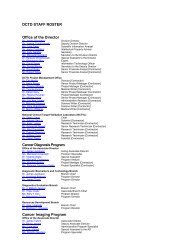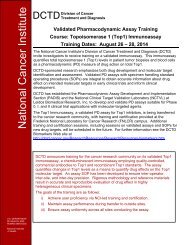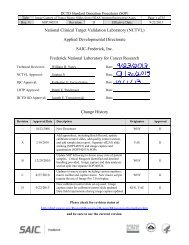National Cancer Institute - NCI Division of Cancer Treatment and ...
National Cancer Institute - NCI Division of Cancer Treatment and ...
National Cancer Institute - NCI Division of Cancer Treatment and ...
You also want an ePaper? Increase the reach of your titles
YUMPU automatically turns print PDFs into web optimized ePapers that Google loves.
The recommendations are organized<br />
according to a format typical <strong>of</strong> articles<br />
appearing in biomedical journals, corresponding<br />
to the introduction, materials<br />
<strong>and</strong> methods, results, <strong>and</strong> discussion<br />
sections.<br />
Repository <strong>of</strong> Molecular Brain<br />
Neoplasia Data Brain Tumor<br />
Repository<br />
http://rembr<strong>and</strong>t-db.nci.nih.gov/<br />
rembr<strong>and</strong>t/login.jsp<br />
REMBRANDT is a national database <strong>of</strong><br />
several thous<strong>and</strong> primary brain tumors.<br />
It focuses on innovation, model building,<br />
<strong>and</strong> validation based on the correlation<br />
<strong>of</strong> diverse data types. An in-depth, multiplatform<br />
query in REMBRANDT can yield<br />
such findings as the existence <strong>of</strong> a particular<br />
genetic marker in all tumors <strong>and</strong> its<br />
relationship to a specific tumor suppressor<br />
gene. Researchers can use REMBRANDT<br />
to explore how genetic changes correlate<br />
with a patient’s response to therapy <strong>and</strong><br />
overall survival within given age groups,<br />
geographical locations, <strong>and</strong> ethnicities.<br />
The database will ultimately be fully open<br />
<strong>and</strong> accessible to all investigators, both<br />
intramural <strong>and</strong> extramural.<br />
Guidelines for Marker Development<br />
http://www.cancerdiagnosis.nci.nih.gov/<br />
assessment/progress/markerdev.html<br />
A researcher, when undertaking identification<br />
<strong>of</strong> a potentially useful marker, must<br />
consider such questions as:<br />
■ Is there a biological rationale for this<br />
marker?<br />
■ ■ ■<br />
The guidelines help researchers evaluate whether markers<br />
or assays are ready for use in clinical settings.<br />
Histological slide showing prostate cancer.<br />
■ Is there an assay system available that is<br />
working in at least one laboratory with<br />
reasonable reproducibility?<br />
■ Has the marker been examined in<br />
normal as well as abnormal/diseased<br />
tissue?<br />
■ Can a patient population be defined<br />
for which this marker may have utility?<br />
What is an expected range for the prevalence<br />
<strong>of</strong> this marker in populations <strong>of</strong><br />
potential interest?<br />
■ Can the marker be measured in the<br />
types <strong>of</strong> specimens that will generally<br />
be available?<br />
To assist researchers who are considering<br />
whether to proceed with development<br />
<strong>NCI</strong> Visuals Online, Dr. Otis Brawley, photographer.<br />
C A N C E R D I A G N O S I S P R O G R A M ■ 43










